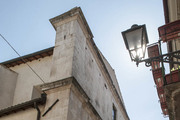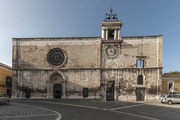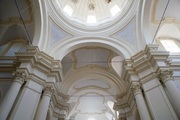![Arciconfraternita della Trinità Arciconfraternita della Trinità]()
L'Arciconfraternita della SS. Trinità di Sulmona è una delle più antiche d'Abruzzo e la più antica di Sulmona, essendo stata fondata agli inizi del XIV secolo.

La cattedrale è intitolata a San Panfilo Vescovo - protettore della città - ed è il più antico tempio di Sulmona; sorge all’estremità settentrionale dell’abitato, piuttosto discosto dal nucleo storico originario. Secondo la tradizione essa fu edificata nell’VIII secolo sulle rovine di un tempio pagano dedicato ad Apollo e Vesta, mentre alcune leggende locali riferiscono che, alla morte del...

La Chiesa del Santissimo Crocifisso di Sulmona è un edificio di origine seicentesca, distrutto dal sisma del 1706 e ricostruito in stile barocco. Il sisma del 1915 ha danneggiato profondamente anche la nuova costruzione rendendo necessari ulteriori interventi di ricostruzione.
La facciata, che culmina in un frontone triangolare, è decorata ai lati da due...

La chiesa della Madonna del Carmine, con l’annesso alloggio per i pellegrini o ospedale, fu eretta nel 1225 per volere di Gentile di Gualtiero di Benedetto Pagano in una zona esterna alla città, fuori Porta Salvatoris. La chiesa, inizialmente intitolata a Sant’Agata, fu ceduta inizialmente dal Pagano al Capitolo di San Pietro di Roma e, successivamente, da questo passò al Capitolo della...

Collocata lungo l’importante asse viario di corso Ovidio, la chiesa della SS. Trinità è documentata a partire dal XVI secolo. La sua storia è strettamente legata a quella dell’omonima arciconfraternita, che vi stabilì la sua sede sul finire del XVI secolo, quando i Padri Celestini della vicina Abbazia di Santo Spirito al Morrone le concessero la chiesa allora denominata di San Giacomo in...

La piccola chiesa, costruita sul finire del XVI secolo dai padri Cappuccini, giunti a Sulmona in quel torno di tempo, sorse a circa tre chilometri dall’abitato in un sito silenzioso e ameno, nella zona del Colle Savente, laddove esisteva già un piccolo oratorio dedicato a San Girolamo.
La data della sua fondazione sembra risalire al 1575-80; la struttura,...

La costruzione della chiesa e dell’oratorio di San Filippo Neri ebbe inizio alla metà del XVII secolo e si concluse nel 1677. La congregazione, però, in principio, ebbe sede - insieme a quella dei Padri Gesuiti - presso la chiesa di Sant’Ignazio, situata in piazza XX Settembre e oggi non più esistente; solo in un secondo momento si trasferì in Piazza Maggiore – l’attuale Piazza Garibaldi -...

La prima menzione della chiesa di San Francesco della Scarpa risale al 1241, anno in cui la sua costruzione era stata già ultimata; nel 1290, per volontà del re Carlo II d’Angiò, venne riedificata ed ampliata in un complesso architettonico molto più imponente del precedente, tale da risultare “la più importante chiesa francescana medievale d'Abruzzo".
...

I Padri Paolotti, dell’Ordine dei Minimi di San Francesco di Paola, giunsero in città probabilmente grazie alla famiglia Capograssi - molto devota al Santo - e si stabilirono nella zona fuori Porta Napoli, dove era la piccola chiesa di Santa Maria delle Grazie.
Nel 1619, infatti, i Sindaci del Comune di Sulmona avevano concesso loro questo sito con alcuni fabbricati e...

La fondazione della chiesa di San Gaetano - l’antica Santa Maria Intus - nota in passato anche con il nome di Santa Maria di Pietraldoni o Pietraluna, risale con molta probabilità all’Alto Medioevo, come testimoniano i recenti rinvenimenti in situ di un’abside semicircolare riferibile al secolo VIII, che conserva tracce di decorazione a fresco con motivo a velario, e di tratti di mura...

La chiesa ha origini antiche, è infatti citata in un documento notarile del 1266 e nel Catasto cittadino del 1376. In origine era di dimensioni minori e fu ingrandita a metà del XVII secolo; il fronte rimase però incompiuto. L’edificio, nelle forme attuali, è frutto della ricostruzione settecentesca, seguita al terremoto del 1706.
Nel 1748 la parrocchia di San Pietro assorbì quella...

Situata sul lato orientale di piazza Garibaldi, isolata rispetto agli edifici circostanti, la piccola chiesa di San Rocco ha origini quattrocentesche. Era precedentemente intitolata a San Sebastiano ed il cambio di dedicazione fu forse dovuto ad una violenta epidemia che si diffuse a Sulmona nella seconda metà del secolo, rafforzando nei fedeli la devozione verso il Santo, protettore contro la...

A lungo si è ritenuto che la piccola chiesa di Santa Lucia e l’annesso convento fossero dimora delle suore Benedettine e che poi, a causa della partecipazione delle religiose alle lotte fra le due famiglie sulmonesi dei Merlino e dei Quatrario, il convento venisse chiuso nel 1406 e passasse ai Celestini che lo abitarono fino al 1656, anno in cui un forte terremoto lo distrusse. ...

Sulla chiave d’arco del portale sono riportate le iniziali del committente, Domenico Cattaneo.
La chiesa attuale non presenta opere di particolare pregio: nel semplice interno ad aula si evidenzia un altorilievo, murato sulla parete destra, che rappresenta Santa Lucia con ai piedi due figure di oranti.

Non si conosce il periodo esatto di costruzione dell’edificio che, nelle forme attuali, sembrerebbe riconducibile ad un intervento di ricostruzione seguito al terremoto del 1706.
Sulla porta d’ingresso furono poste le insegne, oggi non più visibili, della famiglia Merlini, una tra le più antiche ed aristocratiche casate sulmonesi, estintasi verso la metà del Seicento. Le tre lettere...

La chiesa, probabilmente all’inizio conosciuta col nome di Santa Maria di Pietrafitta, è situata nell’area anticamente denominata Montagnano.
Dal 1250 divenne sede dei Cistercensi provenienti da Santa Maria Arabona di Manoppello – che in realtà si stabilirono prima, nel 1232, a Santa Maria dei Corboni in località Marane di Sulmona – da cui sia la chiesa che l’area assunsero...

Secondo la tradizione la chiesa di Santa Maria della Tomba fu eretta sui resti di un antico tempio di Giove o, come riportano alcuni studiosi locali, su parte di quella che sarebbe stata la dimora di Ovidio; il nome deriverebbe invece dall’esistenza di un’antica costruzione, ritenuta un sepolcro, che si trovava lungo la navata centrale, poi demolita nel XVII secolo. In realtà il titolo di Santa...

L’edificio è parte integrante dell’omonima abbazia, della quale ha condiviso per secoli la storia. Il complesso, sorto intorno alla metà del XIII secolo alle pendici del Monte Morrone dall’ampliamento di una cappella preesistente dedicata a Santa Maria del Morrone, per volontà del futuro Papa Celestino V, si sviluppò verso il 1268 con la costruzione di una nuova chiesa, intitolata allo Spirito...

La chiesa è situata nel cuore dell’antico sestiere di Porta Japasseri; nel 1280 fu fondata dai padri predicatori domenicani per volere di Carlo I d’Angiò, particolarmente legato all’Ordine religioso. Inizialmente dedicata a San Nicola di Myra, godette sempre di privilegi e donazioni da parte della casa reale. Il convento, annesso alla chiesa, fu costruito circa un decennio più tardi e dotato di...

La chiesa, con il titolo di San Nicola della Forma, è già citata nel Catasto del 1376 mentre il convento, per tradizione storica, fu costruito dai sulmonesi intorno al 1443 in segno di gratitudine verso San Giovanni da Capestrano, per aver posto fine alle lotte tra i Merlino e i Quatrario che da tempo devastavano la città. Il Santo ne avrebbe poi affidato la cura ai francescani Osservanti o...

Le notizie circa le origini del monastero di Santa Caterina sono discordanti: alcuni studiosi le farebbero risalire al XII secolo, ma la maggior parte di essi ritiene che la storia del complesso abbia inizio nel 1325, con la fondazione del convento femminile domenicano e dell’annessa chiesa da parte di Angelerio - di famiglia locale benché nativo di Caramanico - canonico della cattedrale di San...

La fondazione del monastero di Santa Chiara, situato al margine sud – occidentale di piazza Garibaldi, si fa risalire agli anni compresi tra il 1260 e il 1269 e all’opera della beata Floresenda o Floresella, figlia del conte di Palena, Tommaso di Caprifico. E’ sicuramente uno dei più antichi insediamenti monastici delle clarisse nel Regno di Napoli e, col tempo, diventò anche tra i più ricchi e...

Il complesso, dedicato alla SS. Annunziata e costituito dalla chiesa con l’annesso palazzo, è forse il monumento più rappresentativo e celebre della città di Sulmona, poiché racchiude e sintetizza, anche visivamente, molti secoli di storia e di espressioni artistiche. Chiesa ed ospedale furono fondati nel 1320 dalla confraternita laica dei Compenitenti (o della Penitenza), che aveva...

La piccola chiesa rurale di Santa Maria di Roncisvalle, che sorge in prossimità del tratto occidentale della cinta muraria cittadina sull’antica via romana denominata Numicia o Minucia, lungo lo stesso tracciato del più tardo Regio tratturo, deriverebbe il suo nome - a quanto riferisce la tradizione - da un feroce episodio di sangue avvenuto tra abitanti di Sulmona e quelli di Pescocostanzo. ...






















